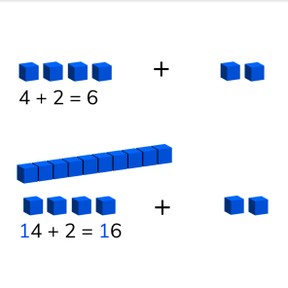



8,000 schools use Gynzy
92,000 teachers use Gynzy
1,600,000 students use Gynzy
General
Students learn that you can simplify the addition problem to tens and ones. If you know the total of the addition problem without the tens, you can calculate the addition problem with tens quickly.
Introduction
Start with a few counting to 20 exercises. Ask students to count and then to explain their counting strategy. It is possible for example to count in groups of 5, 2, or 3. You then decompose numbers to 20 into groups of tens and the ones. For example 13 to 10 and 3.
Instruction
Show students a selection of addition problems that have been simplified into tens and ones. Ask students if they notice anything in particular. They should note that the difference between the two totals is 10. These addition problems belong together. Tell students that you can solve an addition problem with tens faster if you first calculate the ones without the tens. You can use it as a step to your actual total. If you know 4+2=6, you can quickly add 14+2=16. Practice this with MAB blocks. Give students tens of MAB blocks and a few loose blocks. Have students set them out when you name them. For example 6 and 3; on one side 6 blocks, on the other side 3. Ask what the total is. Then they need to add the 10 to the pile with 6 blocks, so the problem becomes 16 + 3. Ask what the total is. Emphasize that the students do not need to calculate the problem again, because they can use the answer from the previous problem only using the ones. You add 10 to the first addend, so you add 10 to the total. You can show on the interactive whiteboard by dragging the ones blocks and tens to where they belong on the interactive whiteboard. Check that they are able to do this without blocks by showing an addition problem with gum. First 5 plus 1 and then 15 plus 1. Practice a few more addition problems with the students, without visual support. They can imagine adding the tens in their heads.
Check that students are able to add to 20 using simplification by asking the following questions:
- 6+2= 8, 16+2 =?
- 4+3= 7, 14+3=?
- 1+4 = 5, Which total can you easily calculate?
Quiz
Students first practice with an addition problem with visual support. They need to give the answer to both addition problems. Next, they solve without visual support, but they are given the answer to the addition problem made of ones. Finally they must solve both the ones and tens addition problem.
Closing
Repeat why it is important to learn how to do this. It is useful because it speeds up calculation. If you know the total of ones (below ten), then you know the sum of the tens addition problem as well. Check that students have understood by doing two addition problems where students have visual support, and a few problems without visual support.
Teaching tips
Students who have difficulty can be supported with MAB-blocks or other manipulatives like the rekenrek or money. Give them a dollar bill and a five dollar bill. They know that 1+5 is 6 dollars. Give them a 10 dollar bill and then they have 11 +5=16. Repeat this with other amounts. Emphasize that they should not recalculate the problem but simply use the total they already have but add ten.
Instruction materials
MAB-blocks (tens and single blocks)
The online teaching platform for interactive whiteboards and displays in schools
Save time building lessons
Manage the classroom more efficiently
Increase student engagement
Discover more!
About Gynzy
Gynzy is an online teaching platform for interactive whiteboards and displays in schools.
With a focus on elementary education, Gynzy’s Whiteboard, digital tools, and activities make it easy for teachers to save time building lessons, increase student engagement, and make classroom management more efficient.



